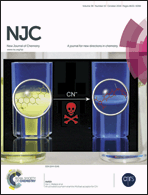Dear NJC Authors,
Today many editors and reviewers evaluate manuscripts “on-screen” (whether this be a computer, a tablet or even a smartphone). It is quite difficult to read manuscripts in which the tables and figures are collected at the end, because the reader then has to scroll back-and-forth between two or even three different pages while reading the text. To facilitate the work of the reviewers as well as the editors, the New Journal of Chemistry Editorial Board has recently adopted a new requirement for submissions to NJC.
This new requirement is described below, along with some additional important information that we ask you to read.
The editors and reviewers thank you for your attention to this new submission requirement. If you have any questions please contact the Montpellier editorial office and we will be happy to help you.
New Submission Requirement
All submissions to NJC must include a file of the “integrated manuscript”: this is a file with all of the tables and artwork integrated into the text at the point close to where the table/figure/scheme, etc., is first mentioned.
– Tables should be complete with the table number and title above the table and footnotes below. Please place the table in the text at a point where the entire table can fit on a single page (unless the table is longer than a single page).
– Figures/schemes/charts should have the number and caption below the artwork. Avoid splitting the graphic over two pages (when possible) by placing it appropriately in the text.
Please see the figure below showing proper presentation of a table and a figure within the text.
Submissions to NJC that do not include this “integrated manuscript” file will be un-submitted, and the author will be requested to upload the “integrated manuscript” file to complete the submission.
Please note that this new policy does not require authors to use the journal template for NJC article types that do not have a limit on their length (regular Papers and Perspective reviews). However, the latest journal template should be used for Letters and Focus reviews, which are limited to 4 and 6 pages, respectively. Please read more about article types below.
Recommendations
To avoid the shifting of inserted graphics/tables during the generation of the pdf file that is read by the editors and reviewers, we suggest to the author to upload a pdf version of their “integrated manuscript” in addition to the native file. The “file designation” to choose when uploading the “integrated manuscript” file(s) is “article”.
When submitting your manuscript, please be sure to select the appropriate “article type” (see the chart below) from the list given during the online manuscript submission process. (A fifth format is also published—Comments—which are meant for scientific comments on a paper previously published in NJC.)













 The October outside cover, designed by Marcus Herlitschke (Jülich Centre for Neutron Science, Germany) et al., presents their paper in which the first experimental results concerning unusual magnetic properties of FeNCN are reported.
The October outside cover, designed by Marcus Herlitschke (Jülich Centre for Neutron Science, Germany) et al., presents their paper in which the first experimental results concerning unusual magnetic properties of FeNCN are reported. The inside cover illustrates a paper written by Karl Wallace (University of Southern Mississippi, USA) and his colleagues who are interested in the design of new molecular probes.
The inside cover illustrates a paper written by Karl Wallace (University of Southern Mississippi, USA) and his colleagues who are interested in the design of new molecular probes.